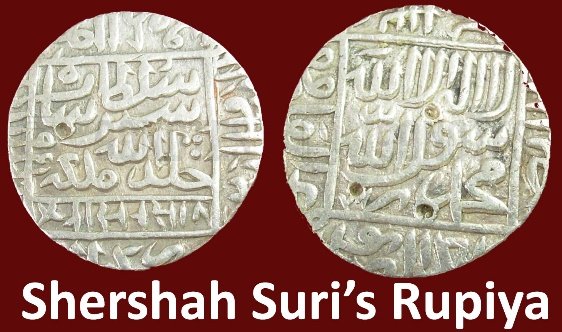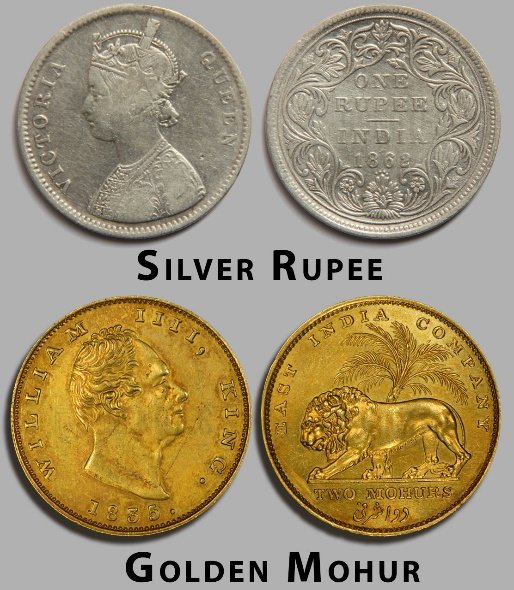History of Currency in India
Introduction of money in the earliest civilisation happened purely out of practical needs, i.e. to facilitate exchange. 
- Indus valley Civilisation: There were no coins in the Indus valley, but clay seals were probably used to facilitate long distance trade, as a mark of guarantee of delivery of consignments.
- Vedic age: In the Vedic age, while the barter system continued, we hear the term ‘Nishka’referred to as a coin, mainly a gold coin.
- Mahajanapada age: For the first time metal coins were introduced.
| How Punched Marked Metal coins act as a medium of exchange? |
| Coins issued by a guild or a monarch ensures that the weight of the precioius metal is standardised. This prevents people from painstakingly measure the weight of the metal delivered each time an exchange has taken place. |
History of Currency in India
Punch Marked Coins: 
Coins made of metal appeared first in the 7th -6th century BCE. The earliest coins are predominantly silver coins, though a few copper coins also appear.
They are called Punch-marked coins because they were punched with several specific figures, one by one. This could have acted as a guarantee of quality and quantity.
Role of Guilds/States:
- The punched marked coins were initially issued by the merchant Guilds and later by the States. They represented a trade currency, a “mark of surety” of future delivery of material. This shows the growth of intensive trade activity and urban development.
- The state-issued coinsare attributed to two different periods: the first is the Janapadas, and the second is the Mauryans.
These coins draw various natural motifs, like the sun, animal motifs, trees, hills, etc., and some are geometrical symbols. However, they carry no script.
Coins of Mauryan age: 
Mauryans issued the largest number of punched-marked coins. This demonstrates the significant growth in economic activities during the Mauryan times.
They used various types of metals to issue coins. Arthshastra names the multiple types of metal coins as follows:
| Name | Metals used |
| Rupyarupa/Karshapana/Pana | Silver coins |
| Tamrarupa /Mashaka | Copper coins |
| Suvarnarupa /Niskha | Gold coins |
| Sisarupa | Lead coins |
Minted coins in India:
Indo-Greeks & Kushans 
Indo–Greeks were the first to mint gold coins in India.
Minting of coin is done by first heating the blank coin before stamping it. This allows following features:
- Coins were more complex in their designs.
- Attribution: These could be attributed to the kings through script or through the image of the king.
- Coins could now carry religious and political symbols. For example, Indo-Greek coins carry several Buddhist symbols. Gupta rulers commemorated several events like Chandragupta-I’s wedding and Samudragupta’s Ashvamedha Yajna through coins.
The number of minted coins increased in number during the Kushans, who maintained high purity of gold throughout their empire which extened till Central Asia.
Satavahana coinage: 
The material culture of the Deccan under the Satavahanas was a combination of local elements and northern ingredients.
- Through contact with the north, the people of Deccan learnt the use of coins, burnt bricks, ring wells, the art of writing, etc.
- They mostly issuedcoins of lead, which is found in the Deccan and coins of copper and bronze.
Gupta coinage:
The Gupta Age is known as the Golden age of India because the Guptas issued the most significant number of Gold coins in Indian history. Guptas called their gold coins as Dinars. 
- The quality of these coins was poorer than the Kushana coins that were issued two centuries earlier.
- The use of cheaper metal coins (such as copper coins) decreased. It means that the ordinary people, who did not transact in gold, shifted to the Bartersystem.
Each Gupta ruler issued many types of gold coins: marriage coins, Ashvamedha coins, archer coins, rhino slayers, lion slayers, horse riders, elephant riders, war coins, etc.
Important Gupta Coins:
- Marriage coin: shows the great alliance formed between Lichchhavis and Guptas when Chandragupta I married a Lichchhavi princess. This coin was issued by Samudragupta.
- Ashvamedha coin: shows the Ashvamedha sacrifice performed by the Samudragupta after the completion of his campaigns in the north and the south.
Chalukya Paise
Chalukyas (9th-10th Century CE) were the first ones to introduce Paise in India. These were known as the Gadhaiya Paise. Until 1950s, a paisa was equivalent to 1⁄64 of a rupee.
Rajput coinage: 
In the 11th– 12th centuries, the coins issued by Rajputs were mostly of gold base, with uniform metrology and common design.
- All coins have an image on the front and the name of the king in the Nagari scripton the rear.
- Apart from gold, the Rajputs circulated copper, billon and silver coins.
- Most coins contain Goddess Lakshmiin some form. Kalachuri coins are the first coins found following this trend.
Dehliwal Coins:
The coins minted in Delhi by the Tomars and the Chamhans were known as the Delhiwal coins. The early Ghurid conquerers minted coins similar to the Delhiwal coins. We also find Ghurid coins with Vishnu’s feet and Nandi. These were probably issued to gain legitimacy among the general public.
These were of copper and significantly less silver. The coins bore the image of goddess Lakshmi or bull-and-horseman, etc. Even Mohammad Ghori issued coins with Goddess Lakshmi with his name inscribed in it in Nagri Script, as was the practice in that time.
Delhi Sultanate Currency 
Delhi sultanate made coins of gold, silver and Billon (copper mixed with a minimal quantity of silver). Barani mentions dirams and dangs, which were used in the capital, Delhi.
The relation between the coins was –
1 silver tanka = 48 jital = 192 dangs = 480 dirams
Through these coins we get to know about a lot of Sultanate history:
- Qutbuddin Aibak took titles such as Malik and Sipahasalar and not Sultan. He didn’t even mint coins in his name.
- Iltutmish standardised the coin system by introducing gold and silver Tankas and a copper jital. ‘Tankah’ (Taka in Magadhi) means a silver coin in Sanskrit. This type of currency got very popular in Bengal; Today ‘Taka’ is the national currency of Bangladesh.
Introduction of token currency: 
- Muhammad-Bin-Tughlaq started the circulation of the token currency of copper coins in 1329-30. These token coins had value at par with silver coins.
- Due to forging and a lack of trust among the subjects and foreign merchants, Muhammad Bin Tughlaq had to recall the token currency at around 1331-32.
- Firoz Shah Tughlaq (1351-1388) introduced new coins, Adha, Bikh, Shashgani and Hastgani.
Currency reforms by Sher Shah Suri 
Sher Shah Suri undertook currency reforms:
- He introduced coins of gold (Mohur), silver (Rupiya), and copper (Dam) of uniform standards.
- Rupiya (Silver coin) was the base of the currency, which was used as the main currency till the British time. The term rupiya was a generic term for silver coin. He standardised this coin with a weight of 178 grains.
Mughal Currency 
In the Mughal period, Coins of three metals, copper, silver and gold, were minted.
- Akbar continued the silver currency Rupayaintroduced by Sher Shah Suri. It was the principal coin used for business and revenue transactions.
- A gold coin called Ashrafior Muhr was issued during this period. However, it was mainly issued for hoarding and gifting purposes.
- Dam, a copper coin, was the most commonly used coin in the Empire.
- Mughals also used ridges at the corners of the several coins to prevent its corner cutting or filing.
In coastal areas, sea shells or Kauris were also used for petty transactions.
| Local conversion in the medieval times |
| In the medieval times the currency was not enough to facilitate the transactions in lower denominations. Therefore people used sea shells (cowrie) for transations.
We often hear about the following transaction rates:
The use of Sea Shells for conversion continued till the arrival of the British empire, after which it was banned from use. These are important elements of Indian cultural history, you might recognise various idioms and phrases using these currency types. These currencies have vanished but their imprint on our culture has been cemented. |
Marathas largely used coins similar to the Mughals; Later under the British empire, the Sardars continued to issue their currencies.
British Empire 
Coins under the British empire were issued in two phases:
- Before 1835, coins were issued by the East India company. During this time each Preisidency independently issued currencies. They imitated the local currencies of the time. The Bengal Presidency standardised the following rate:
64 Pice = 16 Annas = 1 Rupees = 1⁄15 of a Mohur
- In 1835, coinage act of India was passed which standardised the coins throughrout India. Coins were issued by the the British Empire, largely following the conversion adopted by the Bengal Presidency.
A smaller denomination ‘Pie’ was also introduced, with a conversion rate of:
1 Pice = 3 Pie.
The quality of these coins was very high, making forgery and clipping very difficult.
Paper currency 
Paper currency act of 1861 allowed the British Indian government, the monopoly to introduce paper currency in India. Initially Victoria Series Notes were introduced of the denomination of ₹10 to ₹1000.
Due to shortage of silver after the 1st world war, paper currency of one rupee, 2.5 rupees and 5 rupee notes were introduced under the George V series (1923). Additionally, the highest denomination went up to ₹10,000.
After the 2nd world war, nickel alloy and pure nickel coins were introduced, first for lower denominations and then for rupees.
Reserve Bank of India
The Reserve Bank of India (RBI) was established in 1935, through the RBI Act of 1934, which empowered the RBI to issue currencies in India. However, the government continued its printing until RBI itself was capable of its own printing.
First Reform by RBI: Due to forgery by the Japanese government during the 2nd world war two measures were taken:
- The Watermark was changed.
- A security thread feature was introduced.
Currency in Independent India
After Independence, the colonial legacy of coinage was continued.
However, after 1957, the fraction system was gradually done away with and a decimal system was introduced:
- Gradually Annas were removed from circulation.
- A ‘Naya Paisa’ was introduced with a conversion rate of 1⁄100 of a rupee. It was eventually named as the ‘Paisa’. It was minted till 2016, and eventually taken out of circulation.
Further, a series of demonitisations has been taken place throughout the post-Independence history:
- In 1978, high denomination notes such as ₹10,000 were demonetised.
- In 2016, ₹1000 notes were demonetised, and ₹2000 notes that were introduced as its replacement too were demonetised from September 2023.
Currently, Rupee has been standardised as the only currency in circulation in the country. The rupee coins are produced solely by the Government of India, and Banknotes are solely produced by the RBI. The lowest denomination currency is ₹1 and highest is ₹500.
In India, coins are produced in four minting stations:
| Mint | Establishment Year | Mint Mark |
| Kolkata Mint | 1757 | no mint mark beneath the date of the coin |
| Hyderabad Mint | 1803 | ★ beneath the date of the coin |
| Mumbai Mint | 1829 | ◆ beneath the date of the coin |
| Noida Mint | 1988 | ● beneath the date of the coin |
Furthermore, India plans to digitalise its currency using the blockchain technology, limiting its use in the physical form in the coming years. This topic is covered in our Economy book for in depth coverage.






